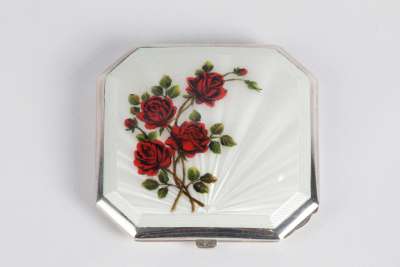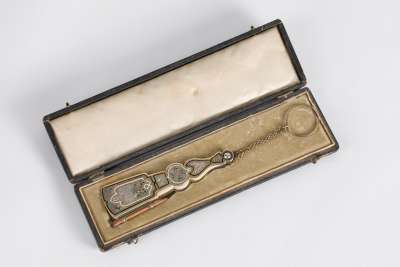The Russian Creamer presented here is a fine example of late 19th-century Russian silver craftsmanship. This piece features a reeded base, typical of the era's design, and carries the marks for 875 silver, indicating its purity. Dated 1896, this creamer was assayed by Aleksandr Timofeyevich Sheryakor in St. Petersburg, a city renowned for its silversmithing in the 1800s. The maker’s marks are somewhat indistinct, a common occurrence in items of this age, but its craftsmanship speaks volumes of its origin.
Condition Report
This Russian Creamer is in very good condition given its age, with minimal signs of wear and aging. The surface maintains a lustrous sheen, indicative of careful preservation over the years. There are no significant blemishes that detract from its visual appeal or structural integrity. The handle and spout remain firmly attached, with no signs of previous repairs. The reeded base is well-defined, and the hallmark stamps, while slightly worn, remain legible, providing essential information about its provenance.
Dimensions
Weight: 174gm, Length: 12cm, Width: 7.5cm, Height: 9cm.
A Functional Table Centrepiece
Originally designed as a creamer, this piece would have been a staple on the dining tables of the affluent in 19th century Russia. Its primary function was to serve cream, a common addition to tea and coffee during social gatherings. The elegant design of the creamer, with its reeded base, would have been both a functional and decorative element, showcasing the owner’s taste and social standing.
Exemplary 19th-Century Russian Design
This creamer exemplifies the late 19th-century Russian design ethos, characterised by its utilitarian elegance and subtle embellishments. The reeded base is a decorative yet modest feature that enhances the piece's visual appeal without overwhelming its primary function. The design harmoniously blends functionality with aesthetic appeal, a hallmark of Russian silverware of the period. Collectors of such items appreciate not only the craftsmanship but also the historical context they represent, embodying a specific era's cultural and social dynamics.
Traditional Silvercraft Techniques
Crafted using silver of 875 purity, this creamer is a testament to the meticulous techniques employed by Russian silversmiths in the 19th century. The process involved casting, forming, and finishing techniques that demanded precision and skill. The hallmarking was a critical step, ensuring the piece's authenticity and quality. Despite the passage of time, the craftsmanship remains evident in the creamer’s smooth surface and the uniformity of its decorative elements, reflecting the high standards of its creation.
Assayed by Aleksandr Timofeyevich Sheryakor
The creamer was assayed by Aleksandr Timofeyevich Sheryakor, active in St. Petersburg between 1895 and 1898. Sheryakor's role was pivotal in verifying the silver content and quality, ensuring that each piece met the stringent standards of Russian silverware during that time. While the specific maker's marks are indistinguishable, the hallmark of Sheryakor provides a significant clue to its authenticity and regional origin, adding historical value to the piece.
Collected by Enthusiasts of Russian Silver
Russian silverware, particularly from the 19th century, is highly sought after by collectors worldwide. Such items are valued for their historical significance and the craftsmanship they represent. Collectors appreciate the nuances in design and the unique hallmarking that narrates the piece's journey through time. Owning a piece like this creamer offers a tangible connection to Russia's rich cultural and artistic heritage, making it a prized addition to any collection of antique silver.















